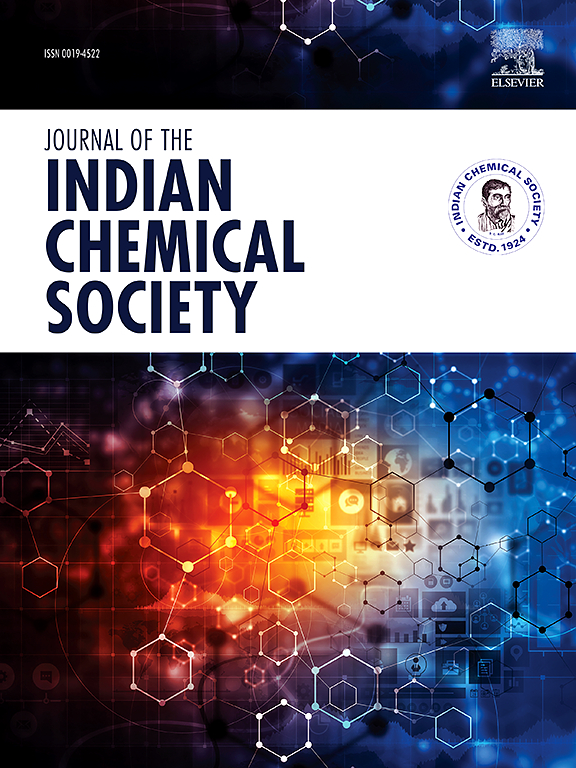Efficient removal of nickel ions from aqueous solutions using dicalcium phosphate Dihydrate: Synthesis and valorization into trinickel phosphate octahydrate
IF 3.4
4区 化学
Q2 CHEMISTRY, MULTIDISCIPLINARY
引用次数: 0
Abstract
Wastewater contaminated with nickel poses a significant threat to the ecosystem due to its toxicity and bioaccumulation in living organisms. This work explores the removal of nickel ions from aqueous solutions through the formation of trinickel phosphate octahydrate (Ni3(PO4)2.8H2O) using dicalcium phosphate dihydrate (DCPD). The experimental method adopted consist to introduce DCPD into aqueous solutions of Ni2+ at room temperature and stirred for different durations. The X-ray diffraction, Infrared Spectroscopy, Differential thermal and thermogravimetric analysis, Scanning Electron Microscopy coupled with X-ray Energy Dispersive Spectroscopy, X-ray photoelectron spectroscopy X, Inductively Coupled Plasma and Impedance Spectroscopy were employed. The results indicate that DCPD exhibits a sorption capacity of 293.467 mg/g for Ni2+, while the recovered phosphates are crystallized into (Ni3(PO4)2.8H2O). The removal mechanism occurs in two distinct stages. The first stage, for a processing time of less than 1200 min, involves an ion exchange between nickel ions in the solution and calcium ions in the phosphate, achieving a maximum exchange of 25 %. The second stage, occurring between 1200 and 8740 min, entails the dissolution of the intermediate precipitated phosphate (Ca0.75Ni0.25HPO4.2H2O) and the concurrent formation of Ca3-xNix(PO4)2.8H2O. This stage culminates in a second ion exchange process, leading to the formation of (Ni3(PO4)2.8H2O). Impedance spectroscopy results further confirm the structural transformation by revealing a two-step electrochemical response. The Nyquist and Bode plots show a transition from surface adsorption at high frequencies to diffusion-controlled ion incorporation at lower frequencies. Electrical circuit modeling highlights the progressive charge transfer and conduction evolution, correlating with the formation of a stable nickel phosphate phase. The final product exhibits high grain boundary resistance, indicating a dense and well-structured material with potential applications in electrochemical systems.

二水合磷酸二钙对水溶液中镍离子的高效去除:合成并活化成八水合磷酸三镍
镍污染废水由于其毒性和在生物体内的生物蓄积性,对生态系统构成了重大威胁。本研究探讨了利用二水合磷酸二钙(DCPD)形成八水合磷酸三镍(Ni3(PO4)2.8H2O)从水溶液中去除镍离子的方法。采用的实验方法是在室温下将DCPD引入Ni2+水溶液中,搅拌不同时间。采用了X射线衍射、红外光谱、差热分析和热重分析、扫描电镜耦合X射线能量色散谱、X射线光电子能谱、电感耦合等离子体和阻抗谱。结果表明,DCPD对Ni2+的吸附量为293.467 mg/g,回收的磷酸盐结晶为(Ni3(PO4)2.8H2O)。去除机制发生在两个不同的阶段。第一阶段的处理时间不到1200分钟,涉及溶液中的镍离子与磷酸盐中的钙离子之间的离子交换,最大交换率为25%。第二阶段发生在1200 ~ 8740 min之间,中间沉淀的磷酸盐(Ca0.75Ni0.25HPO4.2H2O)溶解,同时形成Ca3-xNix(PO4)2.8H2O。这一阶段在第二次离子交换过程中达到高潮,形成(Ni3(PO4)2.8H2O)。阻抗谱结果通过揭示两步电化学响应进一步证实了结构转变。Nyquist和Bode图显示了从高频表面吸附到低频扩散控制离子结合的转变。电路模型强调了渐进的电荷转移和传导演化,与稳定的磷酸镍相的形成有关。最终产物具有较高的晶界电阻,表明这种致密且结构良好的材料在电化学系统中具有潜在的应用前景。
本文章由计算机程序翻译,如有差异,请以英文原文为准。
求助全文
约1分钟内获得全文
求助全文
来源期刊
CiteScore
3.50
自引率
7.70%
发文量
492
审稿时长
3-8 weeks
期刊介绍:
The Journal of the Indian Chemical Society publishes original, fundamental, theorical, experimental research work of highest quality in all areas of chemistry, biochemistry, medicinal chemistry, electrochemistry, agrochemistry, chemical engineering and technology, food chemistry, environmental chemistry, etc.

 求助内容:
求助内容: 应助结果提醒方式:
应助结果提醒方式:


